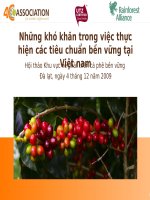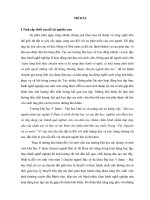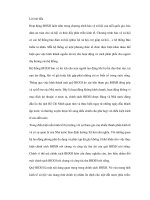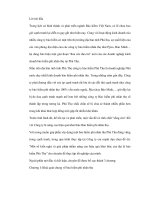Những khó khăn trong việc dịch các bài báo kinh tế trong mục business của trang báo điện tử dân trí quốc tế dtinews com vn
Bạn đang xem bản rút gọn của tài liệu. Xem và tải ngay bản đầy đủ của tài liệu tại đây (933.04 KB, 52 trang )
VIETNAM NATIONAL UNIVERSITY, HANOI
UNIVERSITY OF LANGUAGES AND INTERNATIONAL STUDIES
FACULTY OF ENGLISH LANGUAGE TEACHER EDUCATION
TRANSLATION AND INTERPRETATION DIVISION
GRADUATION PAPER
DIFFICULTIES IN TRANSLATING BUSINESS NEWS AT
BUSINESS COLUMN OF DANTRI INTERNATIONAL
NEWS (DTINEWS.COM.VN)
Supervisor
: Nguyen Xuan Thom, ASSOC.PROF
Name of student
: Tran Thi Phuong
Year of enrolment : QH2011.F.1.E20
HANOI – May 2015
ĐẠI HỌC QUỐC GIA HÀ NỘI
TRƯỜNG ĐẠI HỌC NGOẠI NGỮ
KHOA PHIÊN DỊCH
KHỐ LUẬN TỐT NGHIỆP
NHỮNG KHĨ KHĂN TRONG VIỆC DỊCH CÁC BÀI
BÁO KINH TẾ TRONG MỤC BUSINESS CỦA TRANG
BÁO ĐIỆN TỬ DÂN TRÍ QUỐC TẾ (DTINEWS.COM.VN)
Giáo viên hướng dẫn : PGS.TS Nguyễn Xuân Thơm
Sinh viên
: Trần Thị Phương
Khoá
: QH2011.F.1.E20
HÀ NỘI – NĂM 2015
DECLARATION
I hereby state that I: Tran Thi Phuong, QH2011.F.1.E20, being as a candidate for the
degree of Bachelor of Arts (TEFL) accept the requirements of the University
relating to the retention and use of Bachelor‟s Graduation Paper deposited in the
library.
In terms of these conditions, I agree that the origin of my paper deposited in the library
should be accessible for the purpose of study and research, in accordance with the
normal conditions established by the librarian for the care, loan or reproduction of
the paper.
Signature:
Date:
1
ACKNOWLEDGEMENT
First and foremost, the author would like to extend the most sincere thanks to supervisor
Mr. Nguyen Xuan Thom for his great support, encouragement and suggestions
during the process of accomplishing this thesis. It would be difficult to imagine
how such an undertaking could be finished without his help.
The author would furthermore like to offer her deepest thanks to Dantri News agency for
their useful translation documents and their willingness to participate in the
interview.
Last but not least, the author is indebted to Ms. Do Thi Ngoan for her help in collecting
data and comparing pre-edited and edited articles.
The author agrees that this thesis can be used for research purposes and commits that
none of the contents have been plagiarized.
The author is open to any suggestions or criticisms on shortcomings which inevitably
occur in this work.
2
ABSTRACT
Along with the rapid development of information technology, the newspaper has also
begun a period of development to meet people‟s information demands about
every factor of life, both domestically and internationally. Therefore, to provide
interesting and helpful international articles, a question for news agencies to
consider is how to produce successful translation from Vietnamese to English and
vice versa. This has led to the problems in translating news articles, and
specifically, the difficulties that translators face in dealing with translation of
news.
As a way to help the translators out, this research aims at finding out the most prominant
difficulties that translators have to overcome in translating news articles.
However, newspapers in general cover almost every field of life; therefore it
would be very difficult and complicated for the researcher to gain insights into
every field. After thinking carefully to find out the most relevant factor in daily
life, the researcher decided to focus on economic news articles only, and carry out
the research at Dantri--one of the most popular and reliable news agencies in
Vietnam.
This research report consists of three main parts. It begins with the introduction, which
states the rationale, aims, scope, and methods of the study. Part two includes three
chapters, the first of which reviews the related literature, the second presents the
study in details and the third deals with major findings from the data analysis. Part
3
three is the conclusion, which summarizes the whole study and gives suggestions
for further research.
4
TABLE OF CONTENTS
I.INTRODUCTION ............................................................................................ 1
1.Statement of the proble m ............................................................. 1
2.Research objectives ....................................................................... 3
3.Research questions ........................................................................ 3
4.Significance of the study ............................................................... 4
5.Scope of the study .......................................................................... 5
II LITERATURE REVIEW .............................................................................. 5
1. What is translation ....................................................................... 6
2. Types of translation...................................................................... 9
3. Technical translation.................................................................. 10
4. Translation proble ms and difficulties ...................................... 12
5. Roles of business news................................................................ 14
6. Characteristics of ne ws articles................................................. 14
III METHODOLOGY ...................................................................................... 15
1. Sampling selecting method ........................................................ 15
2. Data collection methods ............................................................. 16
3. Data collection instruments ....................................................... 16
4. Data collection procedures ........................................................ 16
IV FINDINGS AND DISCUSSION ............................................................... 18
1. Research question 1.................................................................... 18
5
2.Research question 2..................................................................... 21
3.Research question 3..................................................................... 23
4.Research question 4..................................................................... 32
V.CONCLUSION.............................................................................................. 35
1.Summary ...................................................................................... 35
2.Limitations of the study .............................................................. 36
3.Suggestion for further studies .................................................... 36
VI.REFERENCE .............................................................................................. 38
6
Chapter I
INTRODUCTION
In this chapter, the statement of the problem as well as the aims and the objectives of the study are
stated. Moreover, it also mentions the significance and design of the research.
1. Statement of the problem:
For centuries, the newspaper has been an essentially effective tool of
communication for mankind. Nowadays, together with the rapid development of
the Internet, the electronic newspaper has been born and become a more userfriendly means of obtaining news because it is more easily accessible with an
Internet-enabled smart phone or a computer. As a result, electronic news agencies
have mushroomed in Vietnam in recent years, including many well-known ones
such as Vietnamnet, Dantri, Vnexpress, and more.
In the age of rapid economic development, business articles have become
one of the key concerns of news readers,
as such articles not only give them
information about economic issues of daily life but open more investment
opportunities as well. However, these agencies have to face many challenges not
just in conveying the economic news in Vietnamese language, but in English as
well, which is not their mother tongue. Being aware of the problem, many
dedicated researches have conducted studies on translation. “Translation Studies”
7
by Susan (2005), “In other words” by Ellen and Kenji (1994), and “Translation
and Translating” by Bell (1991) are but a few examples to name. The studies
cover many issues in translation such as translating poetry, dramatic text, using
techniques and knowledge, and more. However, none of that research examined
the difficulties in translating business newspaper articles. Then, in 2012, AndreeaRosalia Olteanu did a study on “Errors and difficulties in translating economic
news” in an attempt to delve into the challenges of translating articles related to
business news. Olteanu‟s research examined many aspects of translating business
news such as translation quality, errors, difficulties, and consequences of error in
business news; however, there remained inadequacies. The researcher merely
mentions the difficulties in translating from their own point of view. It is essential
that the researcher also collect opinions from other business news agencies about
the challenges in translating business news to make the points more persuasive.
Moreover, said the conclusions laid out in the research are lacking in solidity, and
analytic process. For example, in the part “Translators‟ wrong assumption of
background knowledge”, he should have discovered the causes thoroughly, and
given some examples of wrong assumptions to support her argument.
Discussing the importance of news media to the economic development,
the New York Times business journalist Diana Henrigues (2000) notes that
coverage of the New York stock exchange and NASDAQ, for example, had
doubled in the last ten years of the 20th century. This expanding business news
coverage is of particular importance to organizations attempting to manage their
image because much of what consumers and other external stakeholders learn
2
about companies and the issues that surround them comes from the news media
(Chen and Meindl, 1991). Because of this importance, business news poses an
enormous challenge to news agencies in general, and the editorial staff (including
news translators) in particular.
According to Kantar Media, one of the top audience measurement
companies in the world, dantri.com.vn ranked number two in terms of access rate
in 2012, second only to Google in Vietnam. Opera has the same statistics that
Dantri is right behind
Google in terms of access rate. According to Google
Analytics in 2013, Dantri was accessed by 173 countries in the world through its
English version (DTINews.com.vn). A study at Yale University under a grant
from the Rockefeller Foundation (reported by Sheriffield) was conducted in 1934
about the effectiveness of prestige in communication. In that study subjects are
asked to indicate their agreement or disagreement with statements which are
attributed to different individuals. The extent of agreement is usually higher when
the statements are attributed to “high prestige” sources. Hence, it will be a wise
choice to utilize business news resources and translators in Dantri International
news (DTINews) as the samples in order to fulfill the aims and objectives of the
research. This will certainly be attributable to more reliable and valuable results
of the study.
All the above reasons led the researcher to conduct a study on
“Difficulties in translating news in the Business column of Dantri International
News (DTINews.com.vn)”.
3
2. Research objectives, research questions, and scope of the study
a. Research objectives
Objective 1: First of all, the research paper is expected to find out the challenges of DTINews translators
and editors from 2013-2014.
Objective 2: Subsequently, the most prominant and common difficulties will determined.
Objective 3: Finally, solutions to deal with those difficulties will be suggested by those translators. It is
expected that these suggestions will have helpful implications to business news translation that
can be employed to more effectively translate business articles and texts.
b. Research questions
To achieve this goal, the current research tries to answer the following questions:
1. What are the difficulties faced by translators working for DTINews in translating
business news articles and which are the the most dominant common difficulties?
2. How were the difficulties expressed in some business news articles of DTINews during
2013-2014?
3. What are the solutions suggested by the translators to deal with business news
translation?
c. Significance of the study
The paper will be particularly helpful for students and translators who have to work with
business news/text. Besides, it is also useful for researchers who happen to have an interest in the
topic.
First and foremost, the study is expected to be beneficial for students and translators who have to
translate business news/text. They will, to a certain extent, be aware of the difficulties that have
to be overcome in translating business news/text. Then, based on real context, they may be able
4
to prepare and ready to face the difficulties to produce the best translation of business news/text.
In addition, the paper will provide the suggested solutions of DTINews translators as an
experience sharing. Thence, students and other translators can gain and use some suggestions
from the studied participants to deal with their own situation in translating business news/text.
As a result, this will, to some extent, help to ease business news translation.
Secondly, the study is also expected to serve as a preliminary for further investigation on the
issue. The study has no ambition of forming any universal laws or generalizations. Rather, it is
meant to provide an in-depth understanding on the complexities of the issue, thence help to
establish the foundation for future further investigation on translating business texts in particular,
on translation in general. In a nutshell, the study may act as the first step towards that end.
d. Scope of the study
It is known that difficulties in translation are complicated and involve a lot of theory.
Meanwhile, the timeframe and the researcher‟s experience are limited. Therefore, as it is
indicated in the title “Difficulties in translating business news at Business column of Dantri
International news (DTINews.com.vn)”, this study is not expected to cover all of the related
challenges in translation, but just focuses on the the most dominant difficulties in translating
business news.
Besides, it is noteworthy that the samples of the study will be confined to business news
articles which are translated from Vietnamese into English and published in DTINews.com.vn
from 2013 to 2014. In addition, the translators who act as the participants in this research will be
deliberately chosen so that they can provide highly in-depth information of their situations,
which will be helpful in understanding the complexities of the studied issue.
5
Chapter II
LITERATURE REVIEW
The term of translation and its types are novel to many readers. Therefore, this chapter will
offer the definition of the approaches for readers to have accurate concepts of them.
Moreover, some related studies are also mentioned in this chapter.
1. What is Translation?
Translation was not considered a serious intellectual activity until the seventeenth century
although there were some insightful observations on translation from time to time.
It was only from the seventeenth century onwards that the critics started looking
more closely into the nature of translation. In 1970s, Translation Studies
(henceforth, TS) or Translatology developed into an independent discipline
leading to the establishment of qualified departments in various universities. The
development of translation studies affected significant changes in the principles
and theories of translation during the twentieth century. Prominent contributions
were made by scholars. A good number of translation theorists have defined and
discussed translation i.e. Nida (1969), Catford (1974), Pinchuck (1977), Newmark
(1991), Farghal and Shunnaq (1992), Munday (2001), and others. Nida and Taber
(1969:12) are significant theorists in TS who explained the process of translating
reproducing in the receptor language the closest natural equivalent of the source
language message, first in terms of meaning and second in terms of style. Nida
6
(1969) provides a descriptive approach to the translation process focusing on the
receptor and his reaction. He focused on the equivalence as the translator cannot
avoid subjectivity in translation as he/she is a part of his/her culture. Nida
mentioned two types of equivalences, i.e. first type is formal which focuses on the
message and the other type is dynamic equivalence which is oriented towards the
receptor response. The researcher illustrates below the types in a separate section.
Savory (1968) maintains that translation is made possible by an equivalence of
thought that lies behind its different verbal expressions. Very much similar to this
definition is the one furnished by Catford (1965:20), who is a major contributor to
the theory of translation. In his book, a linguistic theory of translation, he defines
translation as "the replacement of textual material in one language; source
language (SL) by equivalent textual material in another language; target language
(TL)". He describes translation as a uni-directional process, which is always
performed from a given source language to a given target language. In Catford‟s
view, the aim of translation is to find the target language equivalents and he also
gives importance to meaning and spirit in translation. Pinchuck (1977:38) states
that: "Translation is a process of finding a TL equivalent for an SL utterance". In
the definitions appearing in 1960s-1970s, the focus was on the meaning and
message which are rendered in the TL and that the translator has an obligation to
seek for the closest equivalent in the TL. Wilss (1982:112) also defined
translation as "a text-oriented event. Translation is a procedure which leads from a
written source language text to an optimally equivalent target language text and
requires syntactic, semantic and stylistic and text –pragmatic comprehension by
7
the translator of the original text". Newmark is ranked as another prominent
scholar in translation studies. According to Newmark (1991:5) “translation is
rendering the meaning of a text into another language in the way that the author
intended the text”. He gave a detailed treatment to the meaning and he
differentiated between the semantic and communicative translation. The semantic
translation focuses basically upon the semantic content of the ST as the translator
attempts to reproduce the precise meaning of the author. In the communicative
translation, the translator attempts to produce the same effect on the receptor. Bell
stated that translation has been variously defined. He says (1991: 13): " the
expression in another language (or target language) of what has been expressed in
another, source language, preserving semantic and stylistic equivalences". House
(1991) asserted that the main goal of translation lies in rendering the intended
meaning across two different languages. Furthermore, Farghal and Shunnaq
(1999:2) defined translation "as a project for transferring equal meaning from one
language to another". This definition has the key concept "equivalence" in the
process of translating. They sustain that no translator could think of translation
without considering this concept. So, equivalence is an important term that creates
a central problem if it is not taken into consideration. Munday (2001) argued that
the concept of translation may refer to several things. First of all it can refer to the
field of translation in general, it can refer to the product, i.e. a translation of a text,
and it can refer to the process of translating. The process of translating involves a
translator who changes the language of an original ST into another language of a
TT, i.e. changing the language code. He (2001:5) makes reference to Jacobson‟s
8
definition of translation, when seeking to explain the concept. He illustrates the
types of translation; (i.e. the interlingual translation; is also known as 12
„translation proper‟, which involves “an interpretation of verbal signs by means of
some other language”. He maintains that no translator could think of translation
without taking the concept of equivalence into consideration since the notion of it
relates to even the ordinary senses of the verb to translate. Thus, the term
equivalence is a key term in the process of translation and "nonequivalence"
forms a central problem for translator. According to Munday (2001:5), the above
reveals some aspects about the nature of what translation studies are.
Fundamentally, the concept of translation studies refers to the academic discipline
that deals with the studying the problems in connection with translations (product)
and translating (process). The academic discipline of translation studies is a rather
new one. Despite the fact that written and spoken translations have played a
crucial role in human interaction throughout history, the academic discipline of
translation studies has only existed within the past 50 years. From the above
studies, it can be noticed that the theorists and scholars deal with the concept of
equivalence as a major key in most of their definitions and this leads the
researcher to look into this notion which is related to the core of this study.
2. Types of Translation
Translation has been divided into different types by different scholars. “Literal vs. free
translation”, “formal vs. dynamic”, “non- pragmatic vs. pragmatic”, “non-creative
vs. creative” (Ghazala 1995), “word-for-word vs. sense-for-sense” (Shuttle worth
& Cowie 1997), and “Domesticating vs. foreignizing translation” (Venuti 2004).
9
Throughout investigating the differences in types of translation, the dichotomy
basically based on the equivalence principle between the source and the target
texts. This essentially related notion which is the most debated point about
translation will be clearly stated and explained in the forthcoming points. Hence,
the core of each dichotomy above - mentioned will be automatically established.
There are some methods in translation process. Newmark (1988:45-47) mentions
eight translation methods, which are the followings: Word-for-word translation. It
preserves the SL word and translates the words singly by their most common
meanings, out of context. Literal translation converts the SL grammatical
constructions to their nearest TL equivalents, but the lexical words are again
translated singly, out of context. Faithful translation attempts to produce the
accurate contextual meaning of the original within the constraints of the TL
grammatical structures. Semantic translation must take more account of the
aesthetic value of the SL text, compromising on „meaning‟ where appropriate so
that no word-play or repetition jars in the last version. Adaptation is used mainly
for plays (comedies) and poetry; the themes, characters, plots are usually
preserved, the SL culture is converted to the TL culture and the text is rewritten.
Free translation produces the TL text without the style, form, or content of the
original. Idiomatic translation reproduces the 'message' of the original but tends to
change nuances of meaning by preferring colloquialisms and idioms where these
do not exist in the original. Communicative translation attempts to render the
precise contextual meaning of the original so that both content and language are
readily acceptable and comprehensible to the readership. A translator has to be
10
able to choose which translation methods and procedures to be used in translating
a text. The better method a translator chooses, the better he/she will convey the
meaning to the readers.
3. Technical Translation
Technical translation is considered as a part of a disseminating information process on an
international level. The development of the human civilization depends on
interchanging information and knowledge. The transfer of information led to the
process of translation since information needs to be written or printed (Pinchuck
1977:13). Thus, the fast and high development of communication all over the
world encouraged the process of technical translating which is a type of
transferring
information
and
knowledge
from one language into
another.
Newmark (1988) points out that technical translation is one part of specialized
translation; institutional translation, the area of politics, commerce, finance,
government etc., is the other. Technical translation is mainly distinguished from
other forms of translation by its terminology and its grammatical features (for
English, passives, nominalizations, third person, empty verbs, and present tenses)
combined with other varieties of language. However, the main difficulty in
technical translation is usually the new terminology. When translating a technical
text, the translator should read and understand well and then assess its nature
(proportion of persuasion to information), its degree of formality, its intention, the
possible cultural and professional differences between target of readership and the
original one. Newmark (1988:160) states that “perhaps inevitably a technical
translation is so varied in topic and often diverse in register, and so badly written,
11
that it is not easy to make helpful generalizations about it”. Hervey and Higgins
(1992:165) define technical translation as "translation of empirical /descriptive
texts written in the context of scientific or technological disciplines …which, like
any other specialized field, has its own register, jargon and genre making
characteristics''. Hann (1992:7) indicates that technical translation essentially
involves the selection of the correct target – language rendering from a different,
context – dependent alternatives. It is unlike the other fields of translation which
permit certain individuality on the part of linguist with regard to the lexicography
and style. Hann points out that the job of technical translators as being hard and
aggravated by the fact that the translator may not really understand the source
text, a situation that rarely arises in general translation. He says: A good literary
translator strives to produce a target version which is as elegant and readable as
the original, but the technical translator's main priorities are precision and
comprehensibility, since the consequences of lexical error, however slight, are
most serious. A poor literary translation leads to dissatisfied reader, whereas a
misleading technical translation could result in a hazard to human life. (p.7) In
regard to technical translation, there are some points which are considered for the
technical texts; the language of technical texts is
effective in emphasizing
exactness rather than elegance since the focus is on the process which means that
the language is direct and straightforward. It is not adorned with figurative
language, except when the figure of speech would promote understanding.
Pinchuck (1977) points out that the grammar of writing technical texts which does
not differ from the other kinds of writing. They share the common grammar of the
12









